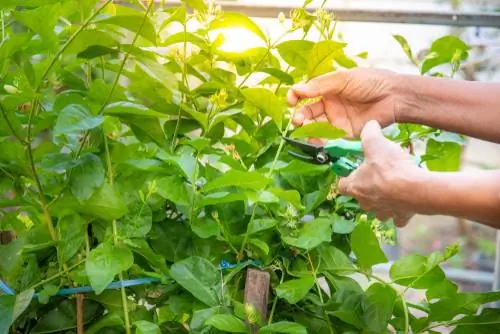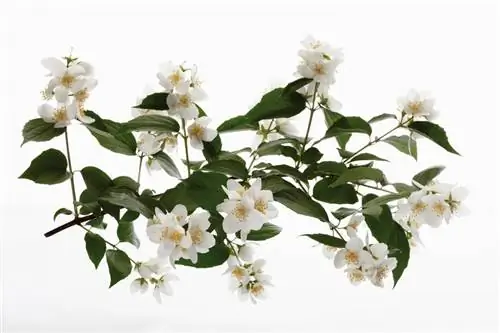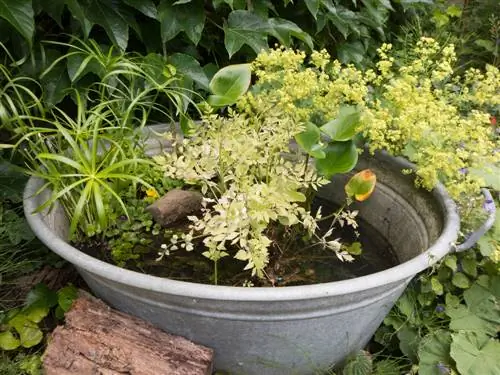- Author admin [email protected].
- Public 2023-12-24 06:09.
- Last modified 2025-06-01 06:02.
Real jasmine is not hardy and is an impressive pot plant. Winter jasmine boasts yellow flowers in the winter garden from Christmas onwards. Garden jasmine or false jasmine is actually a native species of pipe bush. Whether real or not - every jasmine is cut individually. Read all instructions in this tutorial.
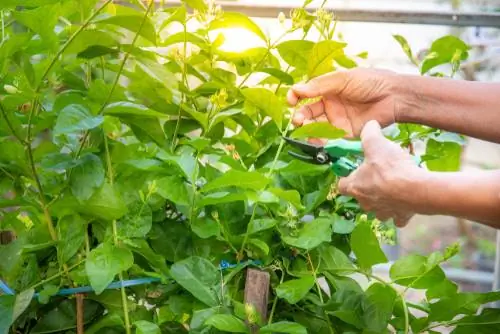
When and how should you cut jasmine?
When cutting jasmine, the right time is crucial: real jasmine (Jasminum officinale) should be cut after flowering, winter jasmine (Jasminum nudiflorum) after winter bloom and garden jasmine (Philadelphus) every 2-3 years in February. Cut back excess, long or dead shoots to promote he althy growth and beautiful blooms.
Jasmine variants - cutting types and dates
Don't be confused by the variety of shrubs that bear the name jasmine. The following table provides an overview of when pruning care makes sense for real jasmine, winter jasmine and garden jasmine as pseudo-jasmine.
| Jasmine variant | botanical name | best cut style | best time | Growth | hardy/sensitive to frost |
|---|---|---|---|---|---|
| Real jasmine | Jasminum officinale | Conservation cut | after flowering | climbing plant | sensitive to frost |
| Winter Jasmine | Jasminum nudiflorum | Shape and care cut | after flowering | climbing plant | hardy to -18° |
| Garden jasmine, false jasmine | Philadelphus | Blending cut | every 2-3 years in February | upright, bushy shrub | completely hardy |
Real jasmine represents at this point the whole host of magnificent species and picturesque varieties that should overwinter behind glass in our regions. Flower beauties such as pink jasmine (Jasminum stephanense), Azores jasmine (Jasminum azoricum) or primrose jasmine (Jasminum mesnyi) all pull together when it comes to pruning care.
Real jasmine - cutting instructions
Real jasmine comes from the green treasury of Asia and is widespread in the Mediterranean region. The opulent flowering tree thrives as an evergreen or deciduous climbing plant. Jasmine makes up for its pronounced sensitivity to frost with its forgiving pruning tolerance. As long as you choose the right appointment for the incision care, you can't go wrong. This is how it works:
- Cut jasmine after flowering
- Cut back shoots that are too long and extend beyond the climbing aid
- Place scissors over a conveniently positioned bud at a distance of 3-5 mm
The amount of cutting depends on your horticultural assessment and the space available. All Jasminum species have powerful growth. Even after cutting back by two thirds, the bushes sprout again. If a jasmine grows over your head during the summer, regulate the urge to spread with moderate pruning.

Cuttings provide cuttings
Don't throw away jasmine clippings carelessly. If you are looking for more specimens, there are usually a number of candidates for propagation through cuttings. Head cuttings and partial cuttings are equally suitable as long as they are 10 to 15 cm long and do not bear any flowers. Remove all leaves from the bottom half. Place each shoot section in a pot with potting soil and put a transparent hood over it. In a partially shaded location at 20 to 25 degrees Celsius there are good prospects of rapid rooting.
Excursus
Wrong cutting time destroys flower buds
For most cold-sensitive potted plants, pruning is on the care plan in the spring before clearing out, like oleander or Dipladenia. This does not apply to real jasmine and its heat-loving conspecifics. The exotic climbing trees lay the buds for the next flowering period the previous year. This does not mean that you should thin out dead, dried or frozen branches in the spring so that your jasmine starts the new season with a habit that is flooded with light.
cutting winter jasmine
Thanks to global warming, more and more gardens are shining with a sea of yellow flowers in winter. Winter jasmine occupies a special position among the Jasminum species in terms of its frost tolerance down to -18 degrees Celsius and its unorthodox flowering period from December to March. This is how you include the individual attributes when caring for the cut:
- Best time is in February/March after the end of the flowering period
- Thimout dead wood and frozen shoots
- Cut back excessively long branches that reach the ground by a third or half
- Ideally derived from a favorable, strong side shoot
- Cut dead side branches along the scaffold shoots to 5 cm short cones
Winter jasmine has its most beautiful flowers on the annual side shoots that sprout from perennial scaffold shoots. A strong pruning to a pair of buds clears the way for magnificent blooms next year. Moderate corrections are easily possible during the summer. From Augustyou should no longer cross your winter jasminebecause from this point on it will produce the next generation of buds.

Thing out winter jasmine in February every one to two years. If long branches hang down to the ground, they take root there. After flowering, cut these shoots back by a third or half. Shorten dead side shoots to 5 cm long cones.
Background
Jasmine tolerates rejuvenation cuts
Jasmine's pruning tolerance extends to the most radical type of pruning available in tree care. If you have neglected the flowering bush for several years when it comes to pruning, rejuvenating it will solve the problem. First, clear out all dead wood at ground level. Then cut back any remaining ground shoots to 20 to 40 cm. This creates the ideal starting point for fundamentally rebuilding a vital jasmine in the following years. It is important to note that you should rejuvenate outdoor winter jasmine by the beginning of March. According to the Federal Nature Conservation Act, only light maintenance cuts are permitted from March 1st to September 30th.
Think out garden jasmine occasionally
The risk of confusion between real jasmine and garden jasmine causes considerable confusion and bitter disappointment as a result of incorrect pruning care. The latter is also known as false jasmine, farmer's jasmine or fragrant jasmine, although it is the pipe bush (Philadelphus).
The popular ornamental tree grows upright to bushy, reaches a height of 3 meters, is completely hardy and yet sensitive to cutting. Its flower wood is vital for up to eight years, so pruning care is limited to occasional thinning. How to cut garden jasmine correctly:
- Best time is every 2 to 3 years in February
- Thin some of the oldest scaffolding shoots at ground level
- As a replacement, leave an appropriate number of young ground shoots standing
- Remove excess, weak shoots
- Broom-like branches that lean towards the ground lead to a lower side branch
As illustrated in the figure below, the pruning care of garden jasmine is veryreserved. A strong cut, such as on real jasmine or winter jasmine, is promptly followed by the loss of at least one flowering period.
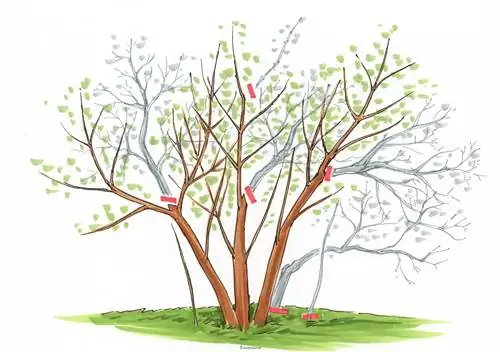
With 7 to 12 scaffolding shoots, a garden jasmine is well positioned. Every 2 to 3 years, thin out some of the oldest ground shoots and leave young shoots as replacements. Strongly branched tips can be slimmed down by directing them to a young side shoot.
Frequently asked questions
Is jasmine poisonous?
Unfortunately, all parts of this noble ornamental tree are poisonous. Even consuming small amounts can trigger typical symptoms of poisoning, such as vomiting, cramps and diarrhea, due to the alkaloids they contain. Larger amounts consumed even carry the risk of respiratory paralysis. The greatest danger to children comes from the berries that form after the flowering period. Cultivation in the family garden is therefore not recommended.
My farmer's jasmine is cut back and thinned out every year. The shrub is now 7 years old and has never really bloomed. What can I do?
Farmer's jasmine is one of the pipe bushes and is not related to real jasmine. For this reason, the shrub will only flower if you thin out dead branches at the base every two to three years. Please refrain from shortening shoots. This causes broom formation and destroys flower buds that have already formed. Apply a phosphorus-rich fertilizer at the end of March to stimulate flowering.
When and how do I cut a winter jasmine so that it grows beautifully?
Starting in August, winter jasmine lays its buds for the next flowering period. Pruning care should be finished by this point at the latest. Only after the end of the late winter flower festival does the time window for shape and care pruning open. The extent to which you trim the ornamental tree depends on your personal assessment. Heavy pruning should be carried out by the beginning of March because, according to the Federal Nature Conservation Act, the grace period begins then, which only allows light pruning.
Is garden jasmine just as suitable for the pot as real jasmine?
Basically, garden jasmine thrives in large containers as long as an adequate supply of water and nutrients is guaranteed. However, the expansive heart root system requires significantly more pot volume than real jasmine with a space-saving shallow root system. Cultivation in the bucket will be successful in the first five to six years. We then recommend transplanting garden jasmine into the bed.
Should there always be a climbing frame available for winter jasmine?
Winter jasmine thrives as a spreading climber. If there are no places for it to hold on to with its adhesive organs, its shoots lie on the ground. A sturdy trellis or an obelisk offers the long tendrils ideal conditions to climb upwards using their own strength.
The 3 most common cutting mistakes
Never cutting vigorous jasmine is just as detrimental to growth and flowering as choosing the wrong time to prune. Anyone who confuses a garden jasmine with real jasmine when it comes to pruning care will look in vain for the fragrant flowers for at least one summer. The following table summarizes common cutting errors with practical tips for prevention:
| Cutting errors | malicious image | Prevention |
|---|---|---|
| never cut | expansive growth | Cut jasmine regularly to shape |
| Jasmine cut in spring | severely reduced blooms | Cut real jasmine after flowering |
| Garden jasmine cut like real jasmine | Failure of flowering period | Think out garden jasmine occasionally |
Tip
The good-natured pruning tolerance of all Jasminum species forgives many a beginner's mistake. Long-term waterlogging, however, reliably destroys the exotic flower beauties. A 5-10 cm high drainage on the bottom of the bucket prevents the mishap. Fill the coaster (€37.00 at Amazon) with pebbles or expanded clay balls so that accumulated water does not rise back into the substrate.

